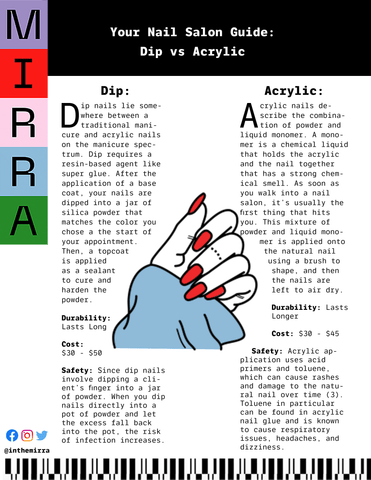Your Nail Salon Guide: Dip vs Acrylic

If you’ve stepped into a nail salon before, you’ve probably caught onto the fact that dip and acrylic manicures are two of the most popular processes you can find. Despite both nails looking similar, there are some vast differences between dip vs acrylic that you should know about before booking.
Contents
1. Dip vs Acrylic: What’s the Difference?
2. Dip vs Acrylic: Which is Safer?
3. Dip vs Acrylic: Similarities
Key Points
- Acrylic nails describe the combination of powder and liquid monomer while dip nails use powder and a mild resin.
- While dip nails are easier to apply and remove, acrylic nails tend to cost less at most nail salon locations.
- Many nail technicians are hesitant to work on dip nails, as the process isn’t considered the most sanitary because of the risk of cross-contamination.
When scrolling on Instagram or Pinterest, it’s nearly impossible to go a few seconds without seeing your favorite influencers post pictures of their new manicure. Most likely, they’re showing off their new trendy design on long, beautiful nails, which means they likely got a gel or acrylic manicure. Understanding the dip vs acrylic debate can help you tailor your choice to best suit your nail goals and to protect your natural nail health.
Dip vs Acrylic: What’s the Difference?
One of the keys to understanding the difference between dip vs acrylic nails is knowing the different ingredients and tools that go into each process. While there are similarities between both, the bonding agents to attach the color to the nail are one of the main differences.
- Acrylic nails: Acrylic nails describe the combination of powder and liquid monomer. A monomer is a chemical liquid that holds the acrylic and the nail together that has a strong chemical smell. As soon as you walk into a nail salon, it’s usually the first thing that hits you. This mixture of powder and liquid monomer is applied onto the natural nail using a brush to shape, and then the nails are left to air dry. Acrylic nails don’t require an LED lamp to cure, unless they are gel acrylics.

- Dip nails: Dip nails lie somewhere between a traditional manicure and acrylic nails on the manicure spectrum. Whereas acrylics require a liquid monomer to form the nails, dip requires a resin-based agent like super glue. After the application of a base coat, your nails are dipped into a jar of silica powder that matches the color you chose at the start of your appointment. Then, a topcoat is applied as a sealant to cure and harden the powder.
Other than the differences in bonding agents and application process, more differences between dip vs acrylic nails include:
- Acrylics are more time consuming and last longer (more durable).
- In terms of cost, every set of nails will have a price based on location and the complexity of the design you choose. However, acrylic nails tend to be a bit cheaper than dip nails. The price for a standard dip manicure is around $30-$50 while the average price for acrylic nails is around $30-$45.
- Dip nails are easier to remove and apply for nail technicians. The easier the nails are to remove; the less strain is put onto the natural nail.
- Dip nails are said to feel lighter and more natural on the nail.
- The powder used for dip nails is an acrylic powder similar to the one used during acrylic application, but dip powder is much finer and designed to work with the resin bonding agent.
Dip vs Acrylic: Which is Safer?
When it comes to safety, both in the salon and for your natural nail, the dip vs acrylic nail debate gets a bit more heated. When it comes to dip nails, the process is more similar to a regular manicure and is less invasive than acrylic nails. However, there are many nail artists and technicians that stray away from dip nails, as they believe the process isn’t sanitary because of the risk of cross-contamination (1).
Since dip nails involve dipping a client’s finger into a jar of powder, they are not supposed to dip several clients’ fingers into the pot. Unfortunately, many salons do this quite often. As you can imagine, when you dip nails directly into a pot of powder and let the excess fall back into the pot, the risk of infection increases.
While gel and dip are considered to be more unsanitary than acrylics, acrylic nails with tips can still harbor more bacteria than your natural nails (2).

On the other hand (no pun intended), dip powder is believed to be better for the natural nail, as it doesn’t use harsh chemicals, like a monomer, to apply the nails. Acrylic application can also use acid primers and toluene, which can cause rashes and damage to the natural nail over time (3). Toluene in particular can be found in acrylic nail glue and is known to cause respiratory issues, irritated skin, headaches, and dizziness.
Additionally, some brands of Dip Powder even add vitamins and calcium into their powder to help promote stronger and healthier nails. Dip is also said to be a bit safer because the layers are not as thick as acrylics, and it reduces the chances of fungal infections or the nail beds breaking (4).
Dip vs Acrylic: Similarities
While there are a lot of differences between dip and acrylic nails, there are some similarities that you should be aware of so you can take them into consideration before you decide which nails you’re wanting at your next appointment.

- They Don’t Require UV Light: Unlike gel manicures, neither dip nails nor acrylic nails use UV lamps in their process. The omission of UV light is beneficial as, over time, the light frequency in an LED light can risk skin aging and likely to damage your natural nail beds.
- The Removal Processes: The removal processes of both acrylic nails and dip nails are pretty identical. Both processes are more involved than removing a simple manicure with nail polish, as the nail technicians will need to cut and file your nails and then soak them in acetone for around 10-15 minutes. Then, the nail technician will apply gentle pressure to lift the product or tips off of your natural nail. This is a crucial step, as the nail bed could break with too much pressure (5). Then, the remaining product is buffed off the nails with a buffing tool.

Written by Selena Ponton
UP NEXT:
10 Healthy Smoothie Recipes to Increase Micronutrient Intake and Aid Digestion
Everything You Need To Know About Estrogen Dominance
SOURCES:
- https://www.elle.com/beauty/makeup-skin-care/a25361250/dip-powder-nails-guide/
- https://www.ajicjournal.org/article/S0196-6553(18)30674-6/fulltext
- https://health.clevelandclinic.org/acrylic-gel-or-dip-nails-understanding-the-pros-and-cons-for-your-health/
- https://pubmed.ncbi.nlm.nih.gov/12244528/
- https://www.allure.com/story/gel-nail-polish-versus-dip-powder-nails-differences






